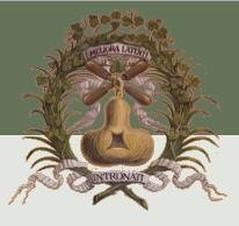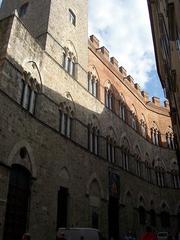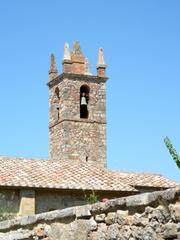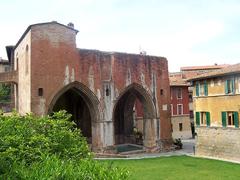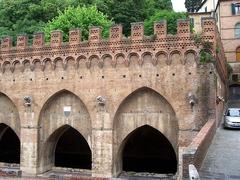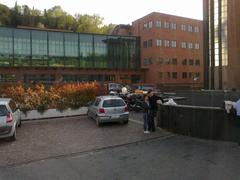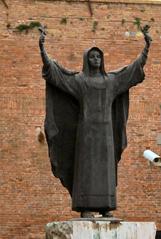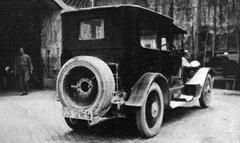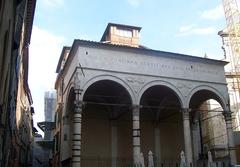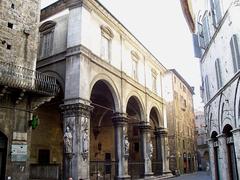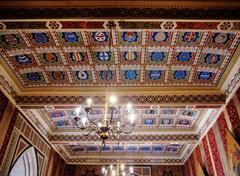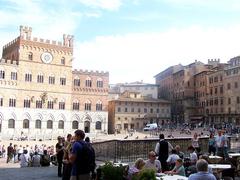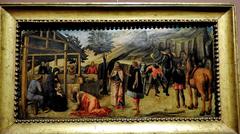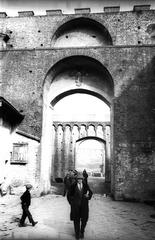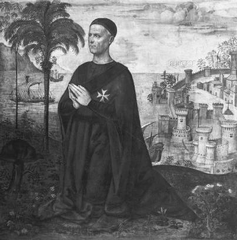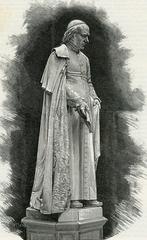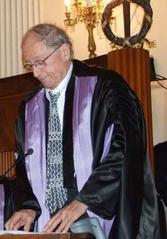Siena Cathedral Visiting Hours, Tickets, and Complete Guide to Siena’s Artistic and Historical Treasures
Date: 14/06/2025
Introduction
Nestled in the heart of Tuscany, the Siena Cathedral (Duomo di Siena) and the adjoining Piccolomini Library offer an unrivaled journey through centuries of religious devotion, artistic achievement, and civic pride. Renowned for its dramatic black-and-white marble façade, the cathedral is a testament to Siena’s medieval ambition and enduring cultural identity. The adjacent Piccolomini Library, with its dazzling Renaissance frescoes by Pinturicchio, further enriches the site, inviting visitors to immerse themselves in the intellectual and artistic fervor of Renaissance Italy. This guide provides detailed historical context, highlights the cathedral complex’s masterpieces, and equips you with all the essential information—visiting hours, ticketing, accessibility, and practical tips—to ensure a rewarding visit to one of Italy’s most treasured historical ensembles.
For the latest visitor updates and expert audio guides, consult the Official Siena Cathedral Website, Siena Tourism Official Site, and Audiala App.
Contents
- Introduction
- Historical Overview of Siena Cathedral
- Architectural and Artistic Significance
- Piccolomini Library: Renaissance Treasure
- The Cathedral Complex: Key Attractions
- Practical Visitor Information
- Visiting Hours
- Tickets & Passes
- Accessibility
- Getting There
- Visitor Conduct & Dress Code
- Tips for an Enriching Visit
- Frequently Asked Questions (FAQ)
- Visual Resources & Interactive Tools
- Conclusion & Further Resources
- Sources
Historical Overview of Siena Cathedral
The origins of the Siena Cathedral date back to a modest 9th-century church. Over centuries, the site evolved into a grand expression of Siena’s religious and civic identity. The present Gothic structure, built primarily between 1215 and 1263, features a Latin cross plan and an imposing dome—its lantern later designed by Gian Lorenzo Bernini. The cathedral’s striped marble symbolizes the city’s legendary founders and echoes throughout its interiors, reinforcing Siena’s unique visual identity and spiritual heritage.
A pivotal moment in the cathedral’s history occurred in 1058, when a synod within its predecessor church led to the election of Pope Nicholas II, underlining the site’s ecclesiastical importance. The cathedral not only served as a center of worship but also as the seat of the Archdiocese of Siena-Colle di Val d’Elsa-Montalcino, bridging religious and civic spheres.
Architectural and Artistic Significance
Exterior and Interior Highlights
Siena Cathedral stands as a masterpiece of Italian Romanesque-Gothic architecture. Its façade, designed by Giovanni Pisano, dazzles with alternating bands of white and greenish-black marble—Siena’s civic colors. The lower façade features sculptural figures of prophets and philosophers, while 14th-century mosaics and pinnacles crown the upper section. Six historic bells reside in the bell tower, the oldest cast in 1149.
Inside, the dramatic black-and-white striped columns support a vaulted blue ceiling strewn with golden stars. The nave is lined with busts of 172 popes and 36 emperors, reflecting the city’s spiritual and political ambitions. The cathedral’s floor, described by Giorgio Vasari as “the most beautiful…ever made,” comprises 56 marble mosaic panels, crafted over five centuries and depicting biblical narratives, allegories, and historical figures. This floor is fully unveiled only during select periods (see Visiting Hours below).
Artistic Masterpieces
- Nicola Pisano’s Pulpit (1265–1268): An octagonal masterpiece in Carrara marble, blending classical and Gothic elements through panels illustrating the life of Christ.
- Donatello’s St. John the Baptist: A striking bronze statue in the cathedral’s chapels.
- Michelangelo’s Piccolomini Altar Statues (1501–1504): Early works by the Renaissance master.
- Bernini’s Baroque Sculptures: Including the lantern atop the dome and expressive angel figures.
- Mosaic Floor: 56 panels crafted by 40 artists between the 14th and 19th centuries, a highlight for art lovers during the annual “unveiling” weeks.
Piccolomini Library: Renaissance Treasure
Commissioned by Cardinal Francesco Todeschini Piccolomini (later Pope Pius III) in 1492, the Piccolomini Library adjoins the cathedral’s left nave. It was intended to house the manuscript collection of Pope Pius II, showcasing Siena’s Renaissance humanism and intellectual vigor.
Artistic Splendor
- Frescoes by Pinturicchio (1503–1508): Ten vivid scenes narrate the life of Pope Pius II, brimming with vibrant colors, elaborate costumes, and Renaissance architectural settings. Notable is the inclusion of portraits of Pinturicchio and the young Raphael.
- Three Graces Marble Group: A Roman-era sculpture at the library’s center.
- Illuminated Manuscripts: The library preserves codices from the 15th century, beautifully decorated by Liberale da Verona and Girolamo da Cremona, among others.
- Architectural Features: The entrance arch was sculpted by Lorenzo di Mariano.
The Piccolomini Library stands as a brilliant testament to Sienese artistic and scholarly achievement, seamlessly blending literature, painting, and sculpture.
The Cathedral Complex: Key Attractions
- Baptistery of San Giovanni: Renowned for its baptismal font, a collaborative work by Donatello, Ghiberti, and Jacopo della Quercia, and richly decorated frescoes.
- Crypt: Discovered in 1999, the crypt houses remarkably preserved 13th-century frescoes, providing a window into early Sienese painting.
- Museo dell’Opera del Duomo: Exhibits original sculptures and artworks, including masterpieces by Duccio di Buoninsegna and Giovanni Pisano, and offers access to the “Facciatone” panoramic terrace.
- Panorama del Facciatone: The unfinished façade offers breathtaking views over Siena and the Tuscan landscape.
Practical Visitor Information
Visiting Hours (as of 2025)
- Cathedral & Piccolomini Library:
- Monday–Saturday: 10:30 AM – 7:00 PM
- Sunday: 1:00 PM – 7:00 PM
- Note: Hours may vary during religious holidays or special events. The marble mosaic floor is fully uncovered for public viewing from late June to mid-July and mid-August to mid-October.
- Other Sites (Baptistery, Crypt, Museum): Check the official website for seasonal variations.
Tickets & Passes
- OPA SI Pass: €15–€20, includes access to the cathedral, Piccolomini Library, Baptistery, Crypt, Museo dell’Opera, and Facciatone terrace. Valid for three consecutive days; one entry per site. (Siena Cathedral Tickets)
- Standard Entry: Cathedral & Piccolomini Library from €8; higher during floor unveiling periods (€10).
- Gate of Heaven Tour: Exclusive rooftop access, €23, limited availability.
- Combo Passes & Day Trips: Options include combined entry with other city sites and guided day tours from Florence.
- Booking: Advance online purchase is highly recommended to avoid queues (sienatickets.com, italy-tourist-information.com).
- Cancellation: Most tickets allow free cancellation up to 24 hours before your visit.
Accessibility
- Wheelchair Access: Most major areas of the cathedral and library are accessible. Some sites (Facciatone, museum, crypt) may be challenging due to stairs and historic architecture. Contact visitor services in advance for assistance and detailed accessibility information (audiala.com).
- Facilities: Accessible restrooms and seating areas are available; strollers are not recommended in certain sections.
Getting There
- Location: Piazza del Duomo, 8, 53100 Siena SI, Italy.
- Transport: The cathedral is in a limited traffic (ZTL) zone; public transport or taxis are advisable. Siena’s city center is walkable but features steep, cobbled streets—comfortable shoes are recommended.
Visitor Conduct & Dress Code
- Dress Modestly: Shoulders and knees must be covered. Hats removed upon entry.
- Behavior: Maintain a respectful silence, particularly during services. Non-flash photography is permitted in most areas; however, restrictions apply in the Piccolomini Library.
- Baggage: Large bags may not be allowed inside; use cloakrooms or hotel storage.
Tips for an Enriching Visit
- Best Times to Visit: Early morning or late afternoon for fewer crowds. The marble floor unveiling is a highlight but attracts higher attendance.
- Suggested Itinerary: Start with the Facciatone terrace for panoramic views, proceed through the museum, Baptistery, Crypt, Cathedral, and conclude with the Piccolomini Library. Add the Gate of Heaven tour if booked.
- Audio Guides: Free audio guides are available via QR code; bring your own headphones. Guided tours can be booked for deeper insights.
- Family-Friendly: Children are welcome, but some areas with stairs or narrow passageways may not be suitable for strollers.
- Nearby Attractions: Combine your visit with Piazza del Campo, Palazzo Pubblico, and Santa Maria della Scala Museum for a comprehensive Sienese experience.
- Amenities: Restrooms are on-site but can be busy during peak hours.
Frequently Asked Questions (FAQ)
Q: What are the Siena Cathedral opening hours?
A: Generally 10:30 AM to 7:00 PM (Monday–Saturday), 1:00 PM to 7:00 PM on Sundays. Check here for updates.
Q: How much are tickets and what do they include?
A: The OPA SI Pass (€15–€20) covers all main sites in the complex. Tickets can be booked online (Siena Cathedral Tickets).
Q: Is the Piccolomini Library included in the main ticket?
A: Yes, entry is included with both the standard ticket and OPA SI Pass.
Q: Is the cathedral wheelchair accessible?
A: Most main areas are, though some spaces may be limited due to historical architecture. Contact visitor services for support.
Q: Can I take photos inside?
A: Non-flash photography is allowed in most areas, but restricted in the Piccolomini Library.
Q: When is the marble floor uncovered?
A: Late June–mid-July and mid-August–mid-October.
Visual Resources & Interactive Tools
- High-resolution images and virtual tours showcase the cathedral façade, mosaic floor, and Piccolomini Library frescoes.
Suggested image alt tags:
- “Siena Cathedral black-and-white marble façade”
- “Interior columns and ceiling of Siena Cathedral”
- “Marble mosaic floor of Siena Cathedral”
- “Frescoes in Piccolomini Library by Pinturicchio”
Conclusion & Further Resources
Siena Cathedral and the Piccolomini Library are not only architectural and artistic marvels but living symbols of Siena’s enduring spirit. With thoughtful planning—utilizing the OPA SI Pass, guided resources, and digital tools like the Audiala app—visitors can fully embrace the beauty, history, and creativity at the heart of Tuscany. Respect dress codes, plan around the spectacular floor unveiling, and explore beyond the cathedral to enjoy the vibrant life of Siena’s historic center. For official information, updated schedules, and expert guidance, always refer to the Opera Duomo Siena Official Website.
Sources and Further Reading
- Discover the History, Visiting Hours, and Tickets for Siena Cathedral and Piccolomini Library, 2025, Opera Duomo Siena (https://operaduomo.siena.it/en/)
- Visiting Siena Cathedral and Piccolomini Library: Hours, Tickets, and Historical Highlights, 2025, Siena Cathedral Official (https://siena-cathedral.com/)
- Visiting the Siena Cathedral Complex: Attractions, Ticketing, and Accessibility, 2025, Italy Tourist Information (https://italy-tourist-information.com/tickets-to-siena-cathedral)
- Siena Cathedral Visiting Hours, Tickets & Practical Tips for Exploring the Piccolomini Library, 2025, Travel Guide (https://operaduomo.siena.it/en/)
- Siena Tourism Official Site, 2025, Discover Tuscany (https://www.discovertuscany.com/siena/)
- Audiala App, 2025, Audiala (https://audiala.com)
